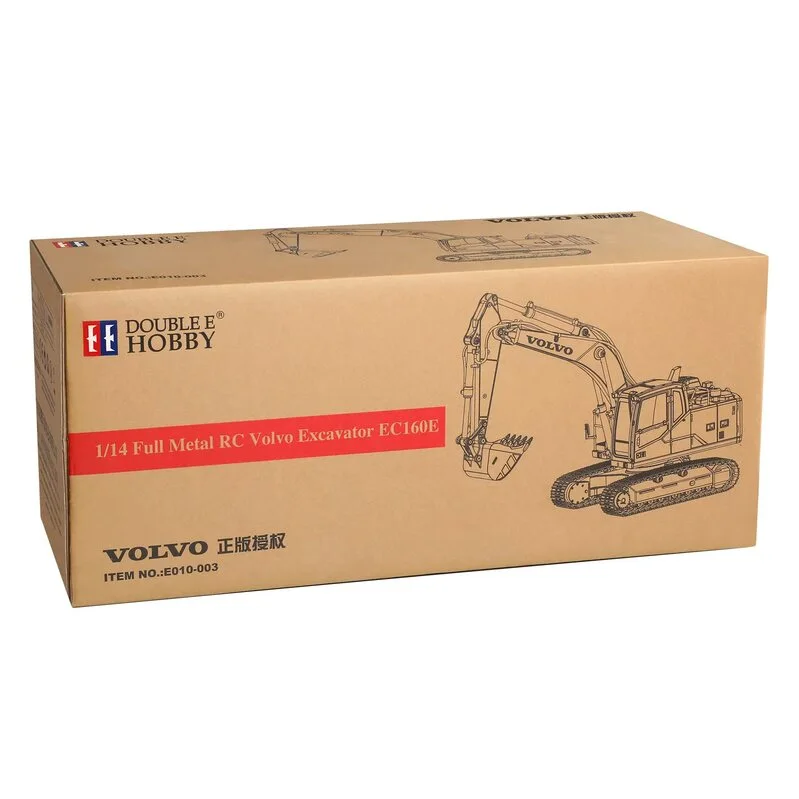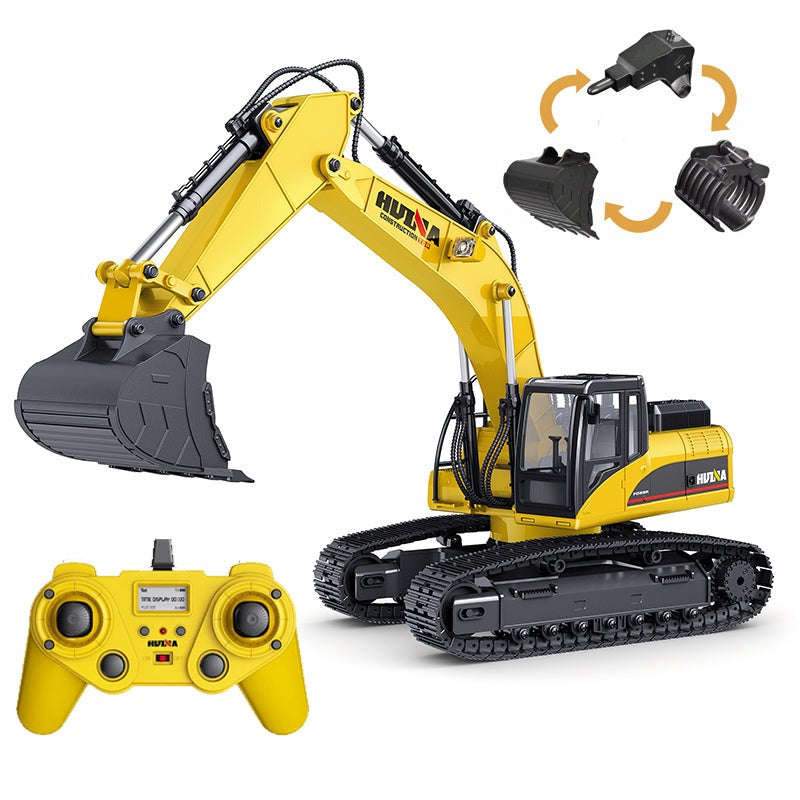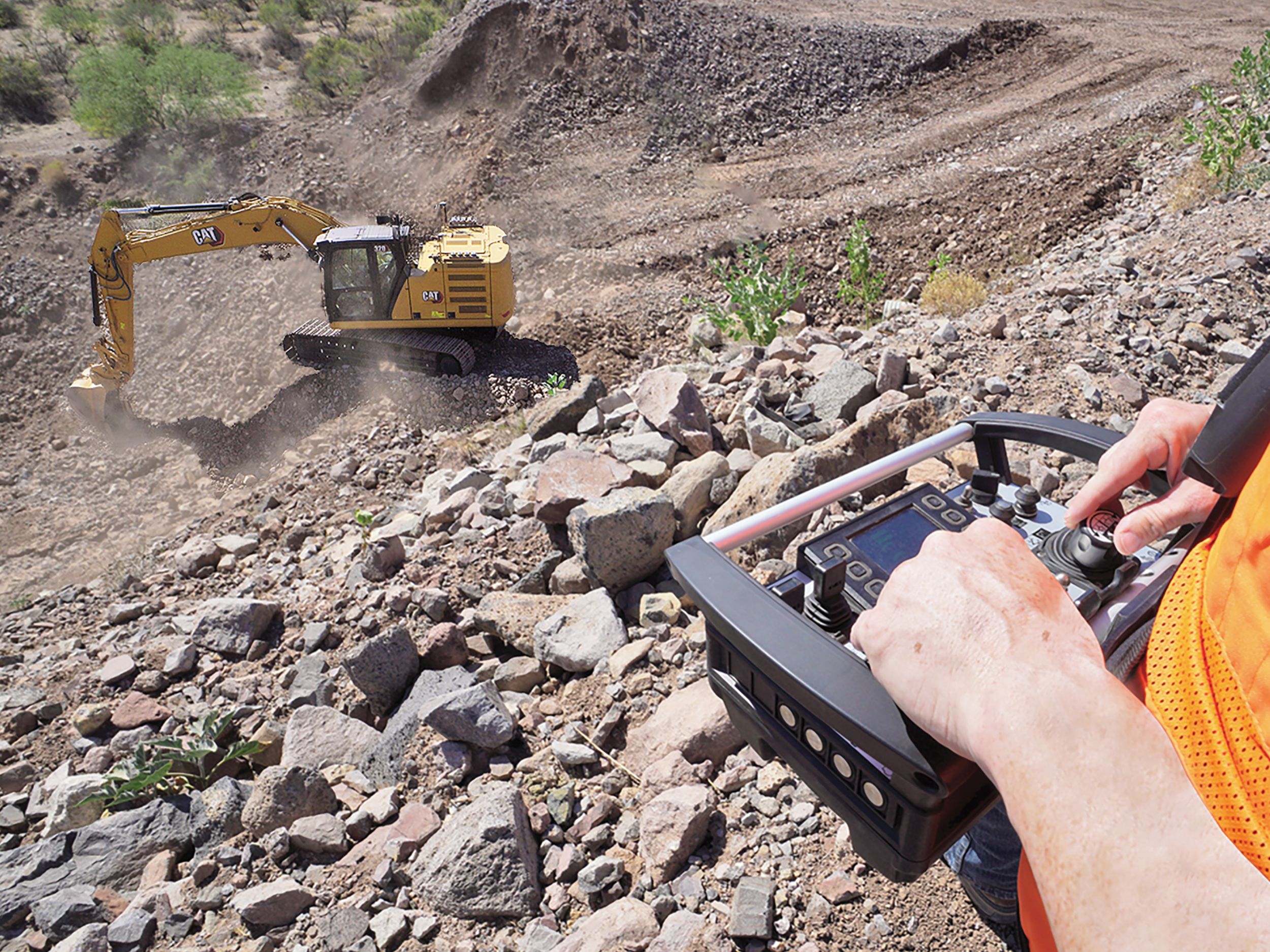The Top Benefits of Integrating a remote control excavator into Your Team
Wiki Article
The Essential Functions of Excavator That Keep It a Must-Have Device
Excavators are indispensable in the building and landscape design sectors. Their versatile add-ons permit a series of jobs, from digging to demolition. In addition, they flaunt premium digging deepness and reach, powered by durable engines. Operator convenience and portable styles improve use in various environments. What really sets excavators apart are their advanced hydraulic systems and longevity. Recognizing these attributes can clarify why they are considered vital tools on any kind of work website.Versatile Accessories for Boosted Capability
Excavators are effective makers on their very own, the enhancement of versatile attachments considerably boosts their capability. These attachments change a conventional excavator right into a multi-purpose device, suitable for a variety of jobs. Buckets, for example, been available in numerous sizes and shapes, allowing operators to dig, scoop, and relocate products effectively. Hydraulic thumbs can be added for boosted gripping and handling of large things, such as logs or rocks.Furthermore, specialized accessories like breakers and augers permit drilling and demolition job, broadening the excavator's energy on building and construction websites. remote control excavator. Grapples are another choice, suitable for relocating and arranging debris. This flexibility not just raises productivity however also lowers the need for multiple devices, saving time and expenses. By outfitting excavators with the appropriate attachments, drivers can take on diverse tasks, making them important in the construction industrySuperior Excavating Depth and Reach
Excavators are developed with remarkable excavating depth and reach, permitting them to steer in limited spaces and access hard-to-reach areas. This ability is essential for numerous construction and excavation jobs, where standard machinery may fail. With flexible boom arms and extendable tracks, excavators can conveniently navigate unequal surface while keeping stability.The excavating deepness can differ considerably amongst designs, typically varying from 10 to 25 feet, relying on the design and objective. This attribute enables operators to excavate foundations, trenches, and various other deep frameworks effectively. Additionally, the reach of an excavator allows for precise excavating and material handling without repositioning the equipment regularly, saving time and labor costs.Ultimately, the exceptional excavating deepness and reach of excavators make them important for specialists seeking to complete intricate tasks with precision and performance. Their flexibility boosts productivity on job websites, showcasing them as a vital device in contemporary construction.Powerful Engine Efficiency

When it comes to efficiency and efficiency on building and construction sites, powerful engine performance plays a crucial role in the abilities of an excavator. A robust engine generates substantial horsepower, permitting the equipment to deal with sturdy tasks with convenience - remote control excavator. This strength translates into faster cycle times, enabling drivers to complete tasks more quickly.Additionally, effective engines give the required torque to handle difficult terrains and varied tons, making sure that the excavator can execute successfully under different conditions. Whether it is raising, digging, or relocating products, the engine's performance directly influences the general functional efficiency of the machine.Furthermore, advancements in engine technology have actually led to boosted gas performance, reducing functional prices while maintaining power outcome. Ultimately, the engine's efficiency acts as the foundation of an excavator, affirming its status as a crucial device in the construction industry
Advanced Hydraulic Systems

Improved Raising Capacity
A considerable improvement in raising ability can be connected to sophisticated hydraulic systems discovered in contemporary excavators. These systems make use of high-pressure liquid to create greater pressure, allowing drivers to lift much heavier tons with simplicity. The design behind these hydraulics warranties peak performance, giving a remarkable power-to-weight proportion that enhances total performance. Because of this, excavators can deal with requiring tasks, such as lifting large materials or equipment, without jeopardizing stability. Furthermore, the robust layout of hydraulic components adds to raised longevity and integrity, making them suitable for various building settings. This enhanced training capacity not just reduces the time required for jobs but also decreases the need for extra machinery, confirming vital for both productivity and cost-effectiveness in the building sector.Enhanced Accuracy Control
Although typical excavators typically battled with accuracy, contemporary hydraulic systems have changed control devices, enabling drivers to perform jobs with amazing precision. These innovative systems utilize proportional control shutoffs that allow for smoother and more responsive motions, considerably lowering the margin for error. Operators can currently finely tune the excavator's movements, making it less complicated to navigate tight spaces and deal with delicate products. Boosted responses systems better educate drivers of real-time performance, making sure perfect sychronisation in between the maker and operator. This enhanced accuracy not only improves performance however also improves safety on job websites, decreasing the risk of accidents. Because of this, modern-day excavators equipped with innovative hydraulic systems are vital tools for building and construction and excavation projects needing thorough precision.Operator Convenience and Visibility
Driver comfort and exposure are vital components in the design of modern excavators (remote control excavator). Features such as ergonomic seat design, improved presence options, and efficient control designs substantially enhance the driver's experience and efficiency. Prioritizing these facets assurances that drivers can work successfully and securely in numerous problemsErgonomic Seat Design
Convenience and presence are critical in excavator layout, with the ergonomic seat playing a necessary function in boosting the driver's experience. An ergonomic seat is engineered to sustain the operator's body, reducing exhaustion throughout long hours of procedure. Adjustable features, such as seat height, back-rest angle, and lumbar support, accommodate specific choices and advertise perfect pose. These changes improve convenience and make it possible for the operator to maintain concentrate on jobs without discomfort. Furthermore, a well-designed seat can provide much better lateral assistance, enabling smoother handling when the excavator functions. This thoughtful style not only enhances efficiency however additionally adds to overall safety and security, making sure that operators can execute their tasks successfully and efficiently.Improved Visibility Attributes
The style of an excavator prolongs beyond why not try these out simply the seat, with enhanced exposure attributes playing a significant duty in driver comfort and general safety and security. Big windows and strategically positioned mirrors offer drivers with a clear sight of their environments, decreasing dead spots. This layout consideration enables better spatial understanding, which is vital in active workplace. Additionally, several excavators incorporate rearview electronic cameras and advanced monitoring systems that assist drivers in steering limited areas. The combination of these exposure features not just promotes safety but also lowers driver tiredness by allowing easier tracking of job areas. Eventually, boosted presence adds to extra reliable operations and assists assure that excavators can execute their jobs efficiently and securely.Control Layout Effectiveness
While maneuvering complicated work websites, an efficient control layout greatly improves both operator comfort and visibility. A well-designed control configuration warranties that operators can access necessary functions with marginal effort, decreasing tiredness throughout lengthy hours. Ergonomic joystick positionings and instinctive switch plans permit smooth operation, allowing operators to preserve emphasis on the task at hand. Furthermore, clear visibility of both the work location and the control board is crucial for safety and security and precision. Modern excavators frequently include flexible seating and control setups to accommodate various driver preferences, further improving convenience. Inevitably, a thoughtfully created control layout not only enhances efficiency however also promotes a much safer working atmosphere by enabling operators to respond quickly to transforming conditions.Compact Layout for Urban Environments
As urban construction websites commonly deal with area restrictions, a small layout comes to be important for excavators running in these atmospheres. These equipments are crafted to navigate limited spaces, allowing for effective ability to move in jampacked task websites. A minimized footprint allows them to function closely to existing frameworks, reducing disturbance and maximizing productivity.The portable design usually includes much shorter tracks and a tighter transforming distance, helping with operation in slim streets and restricted locations. Additionally, light-weight products add to reduce of transport, making it easier to relocate the excavator from one location to an additional within the urban landscape.Additionally, numerous portable excavators are geared up with functions such as extendable arms and versatile accessories, improving their functionality while keeping a little dimension. This adaptability allows operators to deal with a variety of tasks, from excavating to demolition, all while suitable perfectly into the restraints of urban settings.
Resilience and Upkeep Considerations
Durability stands as a necessary consider the efficiency and longevity of excavators, especially sought after metropolitan environments. These machines are subjected to rigorous problems, consisting of differing soil kinds, extreme temperatures, and high-frequency usage. Premium products and robust building and construction are necessary for guaranteeing that excavators can hold up against these difficulties without jeopardizing functionality.Regular maintenance is just as important in maintaining sturdiness. Arranged assessments, timely oil changes, and the replacement of worn components add considerably to an excavator's life-span. Operators should likewise pay interest to hydraulic systems, tracks, and undercarriages, as these parts commonly birth the burden of wear and tear.Investing in resilient excavators with substantial maintenance strategies enhances integrity and lessens downtime, ultimately causing raised efficiency on building and construction sites. Therefore, comprehending the interaction between resilience and upkeep is important for anybody taking into consideration the procurement of an excavator for metropolitan tasks.Regularly Asked Questions
How Do Excavators Compare to Other Building Devices?
Excavators stand out amongst building and construction devices as a result of their adaptability, making it possible for jobs such as training, excavating, and grading. Contrasted to others, their hydraulic abilities provide higher efficiency and power, making them indispensable on various work sites.What Safety Features Are Consisted Of in Modern Excavators?
Modern excavators integrate different safety functions, consisting of rollover protection systems, alarms, and progressed presence enhancements. These components interact to minimize threats, ensuring operator security while boosting efficiency on building and construction websites and various other requiring atmospheres.
Can Excavators Be Used in Wintertime Conditions?
Excavators can certainly be used in winter problems, given they are geared up with appropriate winter season attachments content and safety measures are taken. Appropriate maintenance and adjustments improve their performance, guaranteeing efficient procedure regardless of difficult climate conditions.What Is the Ordinary Lifespan of an Excavator?
The ordinary lifespan of an excavator usually varies from 7,000 to 10,000 hours of operation. This period can significantly rely on maintenance methods, operating conditions, and the particular version's resilience and style features.Just how Do I Choose the Right Excavator Size for My Job?
Picking the best excavator dimension involves reviewing task range, site conditions, and material kinds. Take into consideration aspects like reach, deepness needs, and weight capability to ensure maximum performance and security during procedure. Size issues significantly in job success. Additionally, the reach of an excavator enables for precise digging and material handling without repositioning the maker frequently, conserving time and labor costs.Ultimately, the exceptional digging depth and reach of excavators make them important for experts looking for to complete complex jobs with accuracy and performance. Comfort and presence are extremely important in excavator design, with the ergonomic seat playing a vital duty in enhancing the driver's experience. The layout of an excavator extends beyond just the seat, with boosted presence functions playing a significant role in driver comfort and overall security. Modern excavators commonly integrate adjustable seating and control settings to fit different operator choices, even more boosting comfort. Lightweight products contribute to alleviate of transport, making it less complex to move the excavator from one place to an additional within the urban landscape.Additionally, several portable excavators are geared up with functions Look At This such as extendable arms and versatile add-ons, boosting their capability while keeping a little dimension.Report this wiki page